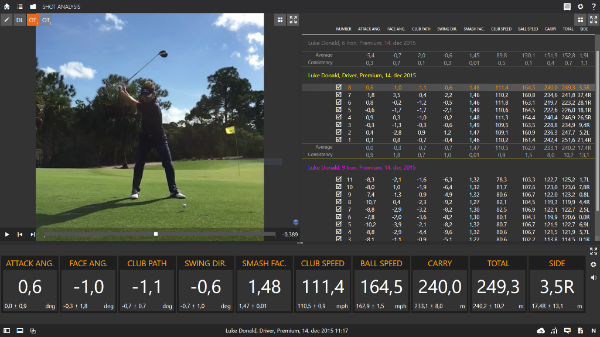The TrackMan Golf Simulator is a game-changer for golfers seeking to improve their swing and overall performance. Its cutting-edge technology provides a detailed analysis of your swing, offering insights that were once only available to professional golfers. Understanding how to interpret and utilize this data can lead to significant improvements in your game. In this article, we’ll explore how to make the most of TrackMan data and transform your swing.
Understanding TrackMan Data
TrackMan captures a multitude of data points during each swing. Here’s a breakdown of the most important metrics and how they can help you refine your game:
1. Ball Speed
Definition: The velocity of the golf ball as it leaves the clubface.
Why It Matters: Ball speed is a primary determinant of distance. Higher ball speed generally means longer shots. TrackMan measures ball speed with precision, helping you assess how efficiently you’re transferring energy from the club to the ball.
Improvement Tips: Focus on solid contact with the club’s sweet spot. Proper technique and a strong swing can increase ball speed.
2. Club Speed
Definition: The speed at which the clubhead is moving at impact.
Why It Matters: Club speed is another key factor in achieving maximum distance. It directly influences ball speed, which in turn affects how far the ball travels.
Improvement Tips: Work on your swing mechanics and physical fitness to increase club speed. Drills focusing on swing rhythm and timing can also be beneficial.
3. Launch Angle
Definition: The angle at which the ball takes off relative to the ground.
Why It Matters: The launch angle impacts the ball’s trajectory and distance. An optimal launch angle ensures maximum carry and roll.
Improvement Tips: Adjust your stance and ball position to achieve the ideal launch angle. Experiment with different clubs to find what works best for your swing.
4. Spin Rate
Definition: The rate at which the ball spins after impact.
Why It Matters: Spin rate affects the ball’s flight and stopping power on the green. Too much spin can cause the ball to balloon, while too little can result in a lack of control.
Improvement Tips: Work on maintaining a consistent swing path and clubface angle. Consider adjusting your grip and stance to influence spin.
5. Attack Angle
Definition: The angle at which the clubhead approaches the ball at impact.
Why It Matters: Attack angle influences launch and spin, which affect distance and accuracy. A positive attack angle generally leads to higher launches and lower spins with drivers.
Improvement Tips: Practice your swing path to achieve the desired attack angle. Use drills to help you consistently hit up or down on the ball, depending on your goals.
Analyzing and Utilizing TrackMan Data
Now that you understand the key metrics, it’s time to put this data to use. Here’s how to analyze your swing effectively:
Identify Patterns and Trends
Review your TrackMan data regularly to identify patterns and trends. Look for consistencies in your swing metrics and areas that need improvement. This analysis can reveal strengths and weaknesses, guiding your practice sessions.
Set Specific Goals
Based on your data analysis, set specific, measurable goals for improvement. Whether it’s increasing club speed or optimizing launch angle, having clear objectives will help you focus your efforts and track progress.
Customize Practice Sessions
Use TrackMan’s data to tailor your practice sessions to target specific areas. Focus on drills and exercises that address weaknesses highlighted by the data. For example, if your spin rate is too high, practice with drills that promote a lower trajectory and controlled spin.
Monitor Progress Over Time
TrackMan allows you to store and compare data from different sessions. Regularly reviewing this data helps you monitor your progress and adjust your training regimen as needed. Celebrate improvements and make data-driven decisions to keep advancing your skills.
Tips for Effective Swing Analysis
Here are some additional tips to help you make the most of TrackMan data:
- Record and Review Sessions: Video recording your swings alongside TrackMan data can provide valuable visual feedback. Compare your technique to the data to identify discrepancies and areas for improvement.
- Consult with a Coach: Working with a golf coach can help you interpret TrackMan data more effectively. A coach can provide expert insights and personalized advice to enhance your training and development.
- Experiment with Equipment: Use TrackMan to test different clubs and equipment settings. Small adjustments in club specs can significantly impact your performance. Experiment to find the best fit for your swing.
- Focus on Consistency: Aim for consistent metrics across multiple swings rather than occasional perfect shots. Consistency is key to developing a reliable and repeatable swing.
- Embrace a Growth Mindset: Approach your swing analysis with a willingness to learn and improve. Use the data as a tool for growth rather than a critique of your current abilities.
Conclusion
The TrackMan Golf Simulator provides invaluable insights into your swing, enabling you to make data-driven improvements. By understanding key metrics, setting specific goals, and tailoring your practice sessions, you can transform your swing and elevate your game. Embrace the power of TrackMan data to unlock your full potential on the golf course, and enjoy the journey of continuous improvement.








